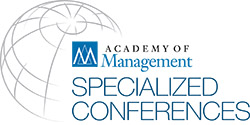Presenter Information
Session Schedule and Timing
The up-to-date conference program is available online. Be sure to check the schedule to ensure there have been no changes to your scheduled session. You, or one of your co-authors, MUST be present at the start of the session.
Session Room Information
Audio/Visual Equipment Set Up: Each room is equipped with a standard audio-visual package that will support an electronic presentation. The package includes the following items:
- LCD Projector
- Projection Screen – Appropriate Size for Meeting Space
NOTE: Laptops, Overhead Projectors, and Flip Charts are NOT provided as standard items. Presenters MUST bring their own laptops, HDMI/VGA switchers, and their own laptop cable adapters.
Presenter Role
Presentations are successful when the audience is motivated to continue the conversation after the session. The following are some ideas for how authors can get the audience engaged and excited about the presentation. The object should be a presentation that covers less but makes a compelling argument that the paper should be read.
Do's and Don't's
|
DO present enough to tell the audience that the paper is worth a read and tell a good story. |
|
DO plan for 10 minutes - it is easier to expand on points than it is to cut things out. |
|
DO use fonts larger than 28 pt and no more than 10 slides. The fonts we suggest using are Times New Roman, Arial, and Tahoma. Use of fonts not included in Windows can lead to unreadable text, words that bleed into graphics or bullets that may be the wrong style. |
|
DO focus on what is interesting and new about what you have learned. Do try to start off with a real-world analogy/story. |
|
DO look people in the eye and talk to them (not at them). Identify places for audience input. Consider using brief exercises or scenarios that draw on the audience's personal experiences / knowledge. |
|
DO answer broadly what we have learned and what needs to be done now. Urge the audience to read the paper for details. |
|
DON'T present summaries of all sections of the paper. |
|
DON'T plan for 20 minutes in case there isn’t extra time. |
|
DON'T use small fonts or too many overheads. |
|
DON'T be too conceptual. |
|
DON'T give a monologue describing your research. |
|
DON'T review each result and summarize what was significant. |
These guidelines are not intended to be rigid. The main point is to sell rather than summarize.
Handouts
Consider bringing a few copies of your proposal (these can be double sided). Have your papers readily accessible for attendees to pick up. If you run out of copies, take the business cards of the attendees interested in your work or write down their addresses.
Presenting
Please arrive at your session meeting room at least 5 minutes before the session begins. Take time to familiarize yourself with the set-up at the lectern. You will control/advance the slides during your presentation. Note: Wireless remotes are not provided as a standard item.
Session Chair/Discussant Role
Your role as the Session Chair/Discussant will be an important and memorable contribution for the presenters and the people attending the session, so we encourage you to read this “Session Chair/Discussant Role” PDF document, which provides helpful tips and tools for shaping an engaging session. Paper sessions consist of three to four papers addressing a common topic and are scheduled for 90 minutes. Please refer to your Session Chair assignment email to view your papers.
